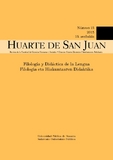Mobile Learning in the Foreign Language Classroom
Palabras clave:
Aprendizaje mediante dispositivos móviles, aprendizaje de lenguas extranjeras, unidad didácticaResumen
Este trabajo estudia el uso del aprendizaje mediante dispositivos móviles en el aula de inglés como lengua extranjera. Primero se realiza una revisión del uso de la tecnología en el aula. Segundo, se define el aprendizaje móvil respecto a las diversas teorías educativas desarrolladas hasta la fecha, como el conductismo y el constructivismo. Tercero, se especifican los rasgos, recursos y funcionalidades que los dispositivos móviles ofrecen para la enseñanza de la lengua extranjera. A continuación se describe el posible desarrollo de las diferentes destrezas y componentes lingüísticos a través de estas funcionalidades. Por último, se ofrece una unidad didáctica que ejemplifica el uso de dispositivos móviles integrándolo en la enseñanza en el aula, concluyendo con una revisión de los posibles riesgos que pueden presentarse por un uso indebido y sus ventajas, presentes y futuras.
Descargas
Citas
Aliende Povedano, I.; Oro Martínez, P. (2009): Mlearning: la formación en tu móvil, La Coruña, NetBiblo.
Ally, M. (2009): «Introduction», en M. Ally (ed.) Mobile Leaning. Transforming the Delivery of Education and Training. Edmonton, AU Press, Athabasca University, pp. 1-8.
Brazuelo Grund, F.; Gallego Gil, D. J. (2011): Mobile Learning. Los dispositivos móviles como recurso educativo, Sevilla, Mad S.L.
Bruner, J. (1966): Toward a theory of Instruction, Cambridge, MA, Harvard University Press. Doi:10.1119/1.2350966.
Camacho, M.; Lara, T. (2011): «M-learning en España, Portugal y América Latina», Monográfico SCOPEO nº 3, Salamanca: Scopeo.
Corbeil, J. R.; Valdes-Corbeil, M. E. (2007): «Are you ready for Mobile Learning?», Educause Quarterly, vol. XXX, nº 2, pp. 51-58. Doi:10.1504/IJMLO.2008.018717.
Cortina-Pérez, B.; Gallardo-Vigil, M.A.; Jiménez-Jiménez, A.; Trujillo-Torres, J. (2014): «Digital illiteracy: a challenge for 21st century teachers», Cultura y Educación, vol. XXVI, nº 2, pp. 231-264.
Council of Europe (2001): Common European Framework of Reference for Language Learning, Teaching and Assessment, Cambridge, Cambridge University Press.
De la Fuente Valentín, L.; Carrasco, A.; Konya, K.; Burgos, D. (2013): «Emerging technologies landscape on education: A review». IJIMAI, vol II, nº 3, pp. 55.
El-Hussein M.; Cronje, J. (2010): «Defining Mobile Learning in the Higher Education Landscape», Educational Technology and Society, vol XIII, nº3, pp.12-21.
Johnson, L.; Smith, R.; Willis, H.; Levine, A.; Haywood, K. (2011): The 2011
Horizon Report, Austin, Texas, The New Media Consortium.
Keegan, D. (2005): «The incorporation of mobile learning into mainstream education and training», World Conference on Mobile Learning, Cape Town. 11. <http://www.mlearn.org.za/CD/papers/keegan1.pdf> (Retrieved 22nd April 2013).
Kolb, L. (2006): Toys to Tools, Washington, ISTE.
Kress, G.; Pachler, N. (2007): «Thinking about the ‘m’ in M-learning», in N. Pachler, (ed.), Mobile Learning: Towards a Research Agenda, London, WLE Centre, Institute of Education, pp. 7-32.
Kukulska-Hulme, A. (2009): «Will mobile learning change language learning?», ReCALL, vol. XXI, nº 2, pp. 157-165.
Kukulska-Hulme, A.; Shield, L. (2008): «An overview of mobile assisted language learning: From content delivery to supported collaboration and interaction», ReCALL, vol. XX, nº3, pp. 271-289.
Mosavi, J.; Miangah, T.; Nezarat, A. (2012): «Mobile Assisted Language Learning» International Journal of Distributed and Parallel Systems, vol. III, nº1, pp.309- 319.
O’Malley, C.; Vavoula, G.; Glew, J.; Taylor, M.; Sharples, M.; Lefrere, P. (2003): «Guidelines for learning/teaching/tutoring in a mobile environment». MOBIlearn project deliverable. [Available at <http://www.mobilearn.org/download/results/guidelines.pdf>] (Retrieved 10th October 2015).
Pachler, N.; Bachmair, B.; Cook, J. (2010): Mobile Learning: Structures, Agency, Practices, London, Springer.
Quinn, C. (2000): «mLearning: Mobile, Wireless, in your Pocket Learning» [Available at <http://www.linezine.com/2.1/features/cqmmwiyp.htm>] (Retrieved 22nd April 2015).
Real Decreto 1467/07, de 2 de noviembre, por el que se establece la estructura del bachillerato y se fijan sus enseñanzas mínimas. [Available at <http://www.boe.es/boe/dias/2007/11/06/pdfs/A45381-45477.pdf>].
Reinders, H. (2010): «Twenty Ideas for Using Mobile Phones in the Language Classroom», ELT Forum nº3, pp.20-33.
Richards, J.; Rodgers. T. (2001): Approaches and Methods in Language Teaching, Cambridge, Cambridge University Press. Doi:10.1017/CBO9780511667305.004.
Texas: The New Media Consortium. [Available at <http://michaeledwardkutch.com/uploads/3/3/1/6/3316493/2013-horizon-report-museum-en.pdf>.].
Traxler, J. (2010): «Education and the Impacts of Mobiles and Mobility», Medienbildung in Neuen Kulturräumen Berlin, VS Verlag für Sozialwissenschaften, pp. 101-111.
Traxler, J. (2005): «Defining Mobile Learning», paper presented at the IADIS International Conference Mobile Learning, 261-266. [Available at <http://www.academia.edu/2810810/Defining_mobile_learning>] (Retrieved 15th October, 2014).
Warschauer, M.; Whittaker, F. (2002): «The Internet for English Teaching: Guidelines for Teachers», in J. Richards and W. Renandya (eds.), Methodology in Language Teaching: An Anthology of Current Practice, Cambridge, Cambridge University Press, pp. 368-383.
Williams, M.; Burden, R. (1999): Psychology for Language Teachers, Cambridge, Cambridge University Press.
Zhao, Y. (2005): Research in Technology and Second language Learning: Developments and Directions, Greenwich, CT, Information Age Publishing, Inc.
Descargas
Publicado
Cómo citar
Número
Sección
Licencia
Todos los artículos son publicados bajo una licencia de uso y distribución Creative Commons (BY-NC-ND 4.0). A cada artículo se le asignará un identificador DOI.
Los autores conservan los derechos de autor y conceden a la revista el derecho de la primera publicación. Los autores podrán establecer acuerdos adicionales para la distribución no exclusiva de la versión de la obra publicada en la revista (por ejemplo, situarlo en un repositorio institucional), con un reconocimiento de su publicación inicial en esta revista. Los trabajos podrán subirse a repositorios institucionales inmediatamente tras la publicación de la revista.
Asimismo, se permite y se anima a los autores a difundir sus trabajos electrónicamente (por ejemplo, en repositorios institucionales, redes sociales académicas o en su propio sitio web).







